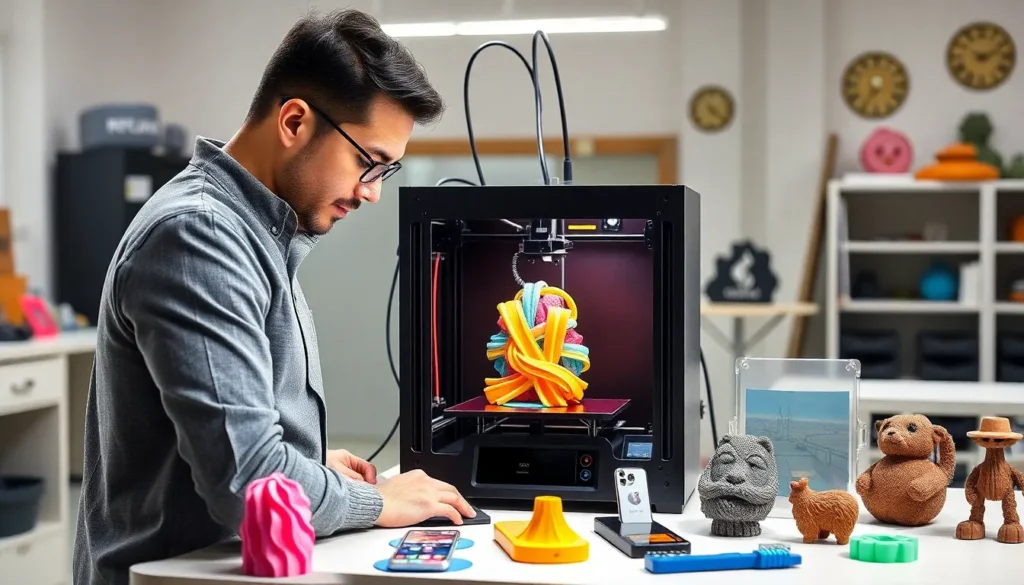Table of Contents
ToggleImagine a world where your wildest ideas spring to life with just a click of a button. Welcome to the fascinating realm of 3D printing, where creativity knows no bounds and the only limit is your imagination. From quirky gadgets to personalized gifts, 3D printing is revolutionizing how we create and innovate.
What Is 3D Printing?
3D printing, also known as additive manufacturing, belongs to a group of processes used to create three-dimensional objects. This technology builds parts by layering materials such as plastic, metal, or resin based on digital models. Various industries utilize 3D printing for rapid prototyping, customized production, and even intricate designs that traditional methods struggle to achieve.
Digital design software creates files that provide precise specifications for each layer. Many companies invest in cutting-edge printers that can print high-resolution items with impressive detail. The process starts by feeding raw material into the printer, which then melts, extrudes, and hardens into the desired shape.
Advancements in 3D printing technology have made it accessible for personal use as well. Hobbyists personalize their creative projects with affordable desktop printers that produce beautiful outcomes. Educational institutions increasingly adopt 3D printers to facilitate hands-on learning experiences in subjects like engineering and design.
While the applications are diverse, the benefits of 3D printing include reduced waste, faster turnaround times, and the ability to manufacture complex geometries. Production runs can adapt quickly to design changes, making it easier to execute ideas. Through innovations in this field, designers push boundaries, transforming concepts into reality efficiently.
Popular 3D Printed Cool Stuff

3D printing creates a wide variety of innovative items, showcasing the technology’s versatility and creativity. Numerous categories demonstrate the potential of this manufacturing process.
Gadgets and Electronics
Gadgets stand out among popular 3D printed items. Customizable phone cases allow for personalized touches, while ergonomic game controllers enhance users’ comfort. Wearable tech creations, such as fitness trackers, provide unique forms tailored to individual needs. Drones also emerge as popular items, enabling enthusiasts to print lightweight yet functional designs. Innovative packaging for electronic components makes shipping safer and more efficient.
Home Decor Items
Home decor benefits significantly from 3D printing. Unique light fixtures capture attention with intricate designs that traditional methods cannot achieve. Customized planters transform indoor gardening with original shapes that fit any space. Wall art in diverse styles can easily be designed and printed to match personal preferences. Additionally, furniture pieces such as chairs or shelves gain a modern touch through additive manufacturing, enhancing the aesthetic appeal of living spaces.
Fashion and Accessories
Fashion evolves with 3D printed accessories leading the charge. Jewelry pieces, including earrings and necklaces, can be uniquely crafted to reflect individual style. Belt buckles and shoelaces also find a place in this realm, demonstrating the ability to mix functionality with custom design. Handbags benefit from lightweight yet durable materials, allowing for intricate patterns without compromising strength. Sunglasses crafted through this technology integrate style and fit for a personalized look.
Benefits of 3D Printing
3D printing offers several advantages that make it a game-changer in various industries. It excels at providing unique solutions to modern challenges.
Customization and Creativity
Customization stands out as a key benefit of 3D printing. Designers can easily create tailored products to meet individual needs and preferences. This technology encourages creativity, allowing for intricate shapes and sophisticated designs that often exceed conventional limits. Personalized items, from custom jewelry to bespoke furniture, exemplify how 3D printing transforms visions into reality quickly. Hobbyists frequently explore 3D printing to express their artistic flair, making unique pieces that resonate emotionally with users. With every project, the potential for innovation expands, highlighting the versatility of this manufacturing approach.
Cost Efficiency
Cost efficiency represents another significant advantage of 3D printing. Producing small batches becomes economically viable since the technology reduces material waste compared to traditional methods. Custom parts can be manufactured on demand, greatly minimizing inventory costs. Rapid prototyping leads to quicker design iterations with less financial risk. Companies often benefit from decreased production lead times, allowing faster market entry for new products. By eliminating the need for extensive tooling, businesses achieve substantial savings while maintaining high-quality outcomes. Thus, 3D printing serves as a catalyst for affordable and effective manufacturing solutions.
Future Trends in 3D Printing
Emerging trends in 3D printing signal a shift toward more sustainable practices. Biodegradable materials play a crucial role in reducing environmental impact, allowing designers to create eco-friendly products. Innovations in material science lead to stronger, lighter composites, enhancing product durability and design flexibility.
Healthcare applications are on the rise, with 3D printing used for creating custom prosthetics and dental implants. Customization opportunities improve patient outcomes, ensuring medical devices fit individual needs perfectly. New bioprinting technologies pave the way for building tissues and organs, potentially revolutionizing transplant medicine.
In architecture, 3D printing gains traction with large-scale construction methods. Structures produced through this technology demonstrate speed and cost savings compared to traditional building methods. Printed homes show promise in addressing housing shortages, as they can be completed in days rather than months.
Education sectors increasingly integrate 3D printing into curricula. Students engage in hands-on projects, facilitating learning through practical applications of engineering and design principles. This experiential learning approach prepares them for careers in STEM fields, driving innovation further.
Art and design communities explore novel expressions with generative design coupled with 3D printing. Artists leverage complex algorithms to create intricate forms that traditional methods can’t produce. Consequently, these unique pieces elevate artistic boundaries, showcasing 3D printing as a medium for creative exploration.
Industry connections strengthen, leading to collaborative projects across diverse sectors. Partnerships between technology providers and manufacturers foster innovation, resulting in advanced production techniques. Enhanced software tools streamline design processes, improving efficiency and capabilities for creators.
The world of 3D printing is a playground for creativity and innovation. With its ability to transform ideas into tangible products it opens up endless possibilities for designers and hobbyists alike. As technology continues to evolve the potential applications in various industries are only set to expand.
From personalized gadgets to sustainable building solutions 3D printing is redefining how products are conceived and manufactured. The future holds exciting prospects as advancements in materials and techniques pave the way for even greater customization and efficiency. Embracing this technology not only enhances individual creativity but also contributes to a more sustainable and innovative future.




